Dynamic Leadership Development
DYNAMIC LEADERSHIP DEVELOPMENT: APPLIED LEADERSHIP THEORY IN PRACTICE
Part A
1. Introduction
In the modern business environment, the qualities of the organisational leader heavily determine the business success of that organisation. In this study, the leadership qualities of Bill Gates as the CEO of Microsoft will be analysed in context of Lewin’s model. Belbin’s model and Tuckman’s model of leadership and team development. Finally, his change management and decision-making skills will also be evaluated.
2. Leadership Style of Bill Gates
The leadership style of Bill Gates is arguably transformational and democratic, as he has always valued the opinions and creativity of the employees working in Microsoft (BBC, 2020). According toBoje and Smith (2010), Bill Gates has been the CEO of Microsoft from 1975 to 2008, and led it to become one of the technology giants in the modern business industry. His main area of supervision was product design, and he has displayed exemplary democratic leadership here, which allowed all the design engineers to contribute innovative ideas to enhance their products and services. Shah and Mulla (2013) argued that according to Bill Gates, the most crucial aspect of a leader is to be able to empower their subordinate employees to deliver their best performance, which highlights his transformational leadership.
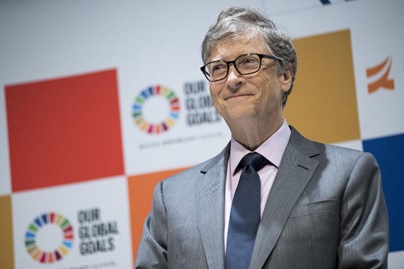
Figure 1: Bill Gates
(Source: Coudriet, 2019)
3. Leadership Theories
3.1. Lewin’s Theory
The theory of leadership developed by Kurt Lewin is basically a model that highlights 3 major types of leadership in the business environment, which are related to the autocratic leadership, democratic leadership and delegative leadership. Popli and Rizvi (2016) argued that an organisational leader usually adopts one of the three different leadership styles, which helps that leader to form a defined relationship with the subordinate employees.
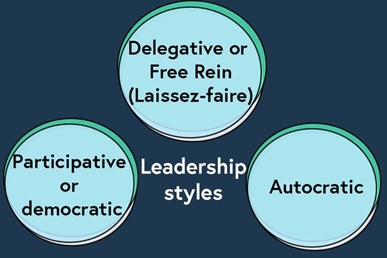
Figure 2: Lewin's leadership styles
(Source: Popli and Rizvi, 2016)
- Autocratic leadership: It is also known as authoritative leadership, which dictates that the leader has to take decisions all by himself without any input from the employees. Furthermore, Bakari, Hunjra and Niazi (2017) argued that in case of an autocratic leader, the decisions are also made by the leader without any kind of consultation with the employees. Such leaders always demand absolute obedience from the employees. However, in the case of Bill Gates, his leadership style is not related to the autocratic leadership, as he has often been seen to initiate personal conversations with the employees where he actively encourages them to express their feedback and opinions.
- Democratic leadership: It is also known as the participative leadership. According to Komarov and Aloyan (2017), the main concept of this leadership is that a leader has to maintain a high level of communication with the employees, and actively ask for their feedback and opinions before making any decision that affects all the employees and their assigned works. In the case of Bill Gates, it can be argued that his leadership style has striking similarities with democratic leadership, as he always maintained communication with the employees and managers in Microsoft in such a way that the feedback and opinions of the managers and employees are always given importance in discussions. In fact, many innovative products of Microsoft originated from such discussions, thus highlighting the efficiency of the democratic aspects of Bill Gates’s leadership.
- Delegative leadership: This leadership style is also called laissez-faire leadership, and it is all about allowing the employees ample amount of freedom so that they can decide to make their own decisions for their job activities to an extent. In other words, Zhang, Cao and Tjosvold (2010) argued that in case of such a leadership style, a leader has a passive role in terms of low-level decision-making. In the case of Bill Gates, he also has glimpses of this leadership style, as the employees in Microsoft were often given a certain level of freedom to decide on their project processes, which accelerated the innovative developments in Microsoft during the time of Bill Gates as its CEO.
3.2. Belbin’s Theory
As per the leadership and team development theory of Meredith Belbin, it can be argued that there is a total of 9 different roles that a team member can play within a team. Depending on the role that suits a particular team member the most, his or her position as a leader or a team member is decided.
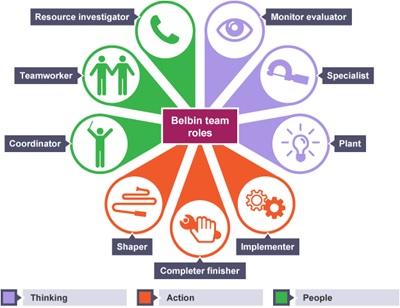
Figure 3: Belbin team roles
(Source: Meredith Belbin, 2011)
These 9 different roles can also be categorised into three broad groups, which are:
Action-oriented roles:
- Completer-finisher: This type of team member always makes sure that the task results are being checked at every stage, so that the final result manages to maintain a certain standard. Furthermore, van Dierendonck and Groen (2011) argued that the error level is minimised due to the presence of such team members.
- Implementer: This type of team member always maintains a high accuracy in the strategic planning of the team operations. Senaratne and Gunawardane (2013) argued that these members are strategists who formulate the workflow designs and efficiently implement them within the team job activities.
- Shaper: According toRuch et al. (2016), this type of team member helps to shape the human resource of the team, and creates a high level of motivation among the team members to shape them for their target job.
People-oriented roles:
- Resource investigator: This type of team member always makes contributions towards the procurement function and research function of a team for its job operations. Batenburg, van Walbeek and in der Maur (2013) argued that such members always find out the most optimal resources needed to be used in the team job operations, and they also manage to maintain a highly efficient team operation blueprint to maximise resource utilisation.
- Team worker: This type of team member always gives their best performance for the team, and maintains a high level of loyalty towards the team of which he or she is a part. Furthermore, French and Kottke (2013) argued that they are also extremely aware of the deadlines set by the team operations guidelines and always aim to achieve them for ensuring their contributions in the teamwork.
- Coordinator: This team member is the one who always maintains a high level of coordination among the members of a team. In fact, van de Water, Ahaus and Rozier (2008) argued that such members have the disposition to become the team leader who can efficiently delegate the team tasks to the appropriate team members.
Thought-oriented roles:
- Specialist: This type of team member has a high level of technical expertise to carry out the particular team operational tasks that require specialised knowledge. Gander et al. (2018) argued that they are usually valued for their greater level of knowledge, and are greatly responsible for the success of the projects carried out by the team.
- Monitor: This type of team member always evaluates the performance of the team in terms of its achievement of the goals. Driskell et al. (2017) argued that such team members are considered to be of the vigilant type who prevents the team project to divert from its goals.
- Plant: This type of team members are usually the problem solvers of the team. Ibn-e-Hassan et al. (2013) argued that they can create innovative solutions and strategies to counter any unprecedented threats and problems that prevent the success of the team projects.
In the case of Bill Gates, Meredith Belbin (2011) argued that he fitted perfectly in the positions of shaper, resource investigator and coordinator. While it is true that he possessed specialised knowledge in computer science and information technology, his role as a leader was to maintain a highly motivated workforce that had excellent coordination among each other. In fact, it was also seen that it was due to the excellent resource finding capability of Bill Gates that Microsoft managed to create ground-breaking operating systems such as Windows.
3.3. Tuckman’s Theory
The team development process explained by Tuckman can be considered to be one of the most popular and valid models of team formation, and according to this model, the entire process of team development is comprised of four different stages that appears in a sequential order while a team is being formed and operating within a business organisation. Furthermore, Tuckman (2013) argued that this model also dictates the role of the team leader at each stage of the team formations and operations.
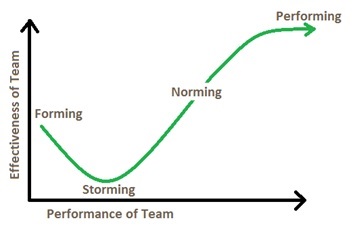
Figure 4: Tuckman's team development model
(Source: Tuckman, 2013)
These stages are:
- Forming: This is the very first stage of team formation, and this stage involves creating the first level of introduction among the team members. In this stage, the team members do not have any familiarity with each other at all, and thus the guidance of the team leader is the most crucial factor in the success of this stage. Super (2020) argued that the team leader has to deliver proper guidance and information regarding the assigned job designations of each member within the team. Furthermore, the team leader also has to handle any kind of conflict that arises within the team at this stage.
- Storming: This stage is the next stage, where the team members have become accustomed to their positions within the team and have made acquaintances with their fellow team members to an extent. Thus,Fransen, Weinberger and Kirschner (2013) argued that initial conflicts are reduced in this stage. However, now that a defined power hierarchy has been established within the team, power struggles and authority conflicts can emerge, which the leader has to handle.
- Norming: This stage is where the leader finally manages to establish a certain level of control over the entire team, and project the team vision and goals among the subordinates. Furthermore, Natvig and Stark (2016) argued that the leader also instils the sense of commitment among the team members at this stage.
- Performing: This stage is where the team finally manages to deliver a high-level performance through their excellent coordination and efficiency. Bonebright (2010) argued that conflicts are least at this stage, and all the employees have clear vision regarding their team goals and objectives.
4. Most aligned theory with Bill Gates
It can be argued that among the three theories discussed above, Lewin’s theory of leadership styles is the most appropriate theory to explain the leadership style of Bill Gates. The leadership style of Bill Gates is mainly a blend between the democratic style and the delegative style. The reason behind this is that it has been seen in the career of Bill Gates that he has never dictated a business decision without consulting with other managers about its possible positive and negative impacts. Furthermore, Ingerson and Bruce (2013) argued that the overall business operations of Microsoft are centred on developing software, and Bill Gates often asked for the opinions from the employees and managers regarding the possible innovative designs of their new software. This kind of participative leadership is one of the reasons that Bill Gates managed to maintain such a high quality of innovation in every new release of Windows OS.
Jin and Yeo (2011) argued that the delegative aspect of the leadership of Bill Gates is also evident, as he allowed many of the employees working in Microsoft to maintain their own ideas as part of their activities. He even allowed the employees to take decisions about the project operations, especially the research and development department employees. This created a high level of innovation in Microsoft, bolstering the efficiency of Bill Gates’s delegative style of leadership.
5. Leadership Style of Bill Gates in context of change management
Due to Bill Gates having a high level of participative and delegative leadership qualities, he adopted a transformational approach for change management in Microsoft. In fact, he implemented the change management model of Kurt Lewin, which involved three distinct steps, which are unfreezing, changing and refreezing.
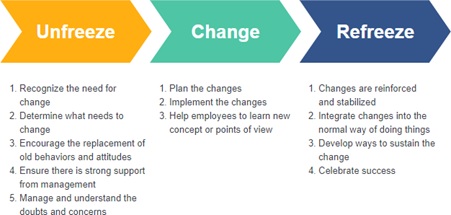
Figure 5: Lewin's change management model
(Source: Burnes and Bargal, 2017)
Bill Gates applied the stage of unfreezing through seminars and group talks, where he personally emphasised the importance of the change. Visser and Courtice (2011) argued that the actual change process was also carried out through collaboration between employees and managers, and Bill Gates always asked for their opinions while implementing the change step by step. Finally, the refreezing was carried out by integrating the changed values into the vision of Microsoft, which inspired the employees and managers.
6. Leadership of Bill Gates in context of team motivation
Team motivation skill of Bill Gates is arguably one of the best in the entire history of the business industry. During the decades of 1990’s and 2000’s, Microsoft was given a belittling nickname ‘Mickey-Soft’ by its competitors Apple and IBM, referring to the smallness of Mickey Mouse(Dixon, Horton and Weir, 2011). However, Bill Gates managed to keep a high employee motivation during that period, and gradually led Microsoft to the position of world’s best professional operating system supplier. Bill Gates motivated the employees by encouraging them to think innovatively, and increasing their commitment and loyalty to the organisation. This created highly motivated and dedicated research and development teams in Microsoft, resulting in excellent organisational growth (Forbes, 2020).
7. Leadership of Bill Gates in context of decision-making and problem-solving
The decision-making capabilities of Bill Gates was also excellent, as he has taken several decisions that contributed to the growth of Microsoft. It is to be noted that despite having a participative leadership style, Bill Gates took several high-level product design decisions by himself, even going against the opinions of the majority of employees in Microsoft. According toGreen and McCann (2011), most of such decisions have proven to be quite successful and beneficial and long-term, such as giving major focus on the operating system development, which led to the development of Windows OS. Furthermore, Bill Gates has always been highly accepting towards innovative ideas, and many of his decisions are innovative in context of the contemporary market trends.
8. Conclusion
The leadership style of Bill Gates is found to be mainly democratic and transformational, which focuses more on the employee expertise development rather than organisational profit. This leadership style has allowed Bill Gates to capitalise on the innovative capabilities of employees in Microsoft. This has allowed Microsoft to gain several ground-breaking innovations in product designs, and experience unprecedented success in Bill Gates’s era.
Part B
Introduction
According to Dressler et al. (2018), Gibbs reflective cycle is basically a process involving six different stages, which helps a person to improve his or her capabilities. Potter (2015) argued that the purpose of Gibbs reflective cycle is to develop the skills through reflecting on experiences. The reason I chose Gibbs reflective cycle to develop my leadership skills is that it enhances my observations and analytic skills as well, which further contributes to my leadership skill development.
1. Description
Previous leadership style
My previous leadership style was mainly related to the coaching and democratic leadership style. In fact, I have always managed to maintain a high level of importance to the team members, which helped me to maintain a cordial relationship with them. Furthermore, I always guided the team members who lacked knowledge regarding the team job operations, and I also tried to solve all conflicts that arose among the members of my team. I usually took decisions after consulting with them about those decisions. However, I always finalised the decisions, and I also made changes in those decisions that I felt are necessary to ensure the success of the team.
Present leadership style
In the present time, my leadership style has remained mostly the same, although some changes have been experienced by me. In fact, I believe that my decision-making process has experienced certain changes. For instance, I now put more emphasis on making the decisions by myself rather than consulting with the team members. Even now, I take the feedback of the team members, but now I only utilise those feedback to gain a good understanding about the various aspects of the decisions, so that I can make my decisions better. Apart from this, I have also reduced the amount of time that I spend while coaching the new employees. Now, I prefer them to learn while working with the experienced members in the team.
2. Feelings
While leading teams in the past, I felt that I enjoyed teaching others. In fact, I always enjoyed communicating with my team members while teaching them about the team operations, strategies and technical aspects whenever possible. Furthermore, I also felt that team coordination is extremely important to ensure the success of the team operations, and thus I always tried to resolve the conflicts arising among the team members, and enhanced the team coordination. Furthermore, I also felt that while considering the opinions of the team members for the decision-making purpose, I managed to show the team members that they are important for the team, which increased their dedication and loyalty to the team.
3. Evaluation
My results in test 1 indicates that I have a well-developed democratic leadership style, while my transformational leadership style and coaching leadership style are also present, although not quite highly. Furthermore, the result of test 2 for me is 69, which indicates that I already have a moderate level of capability to communicate the team goals and vision. This is an extremely important skill for a leader, as without a clear understanding of the team goals, a team can never perform efficiently. The result of the test 3 shows that I scored above 59 in all aspects of team leadership, except directions. Thus, my directional capabilities need some improvement, which involve inspiring the team members to move forward towards the direction I am taking them. Furthermore, my test result 4 is 56, which indicates that I actually am highly motivated to lead an organisation, and my test result 5 also indicates that I have an excellent growth mindset. Thus, it can be argued that I am a motivated transformational democratic leader who has a drive for growth.
Personal impact on me by Bill Gates
As Bill Gates himself is a democratic leader with unique tendencies that can be termed as characteristics of a delegative leader, I can relate myself with his leadership style. This is because I myself am a transformational leader who believes that team member interactions and feedback are extremely important, which helps me to enhance the quality of the decisions, and establish the loyalty and commitment of the team members at the same time. Furthermore, I have also realised that delegating certain team operations to expert employees speed up the entire team activity and enhance the overall team efficiency.
4. Analysis
My scores in test 6 indicate that I have maintained a high level of social awareness. However, my relationship management is not very good, which has created the issue of low capability to maintain relationships. Furthermore, my Belbin test result indicates that I am mainly a team worker who prefers coordinating with the teammates. My Rosenberg test score is 19, and my Hanson test result is 217, which indicates that it is much more efficient for me to adopt a transformational leadership style, and for that I will need to improve my relationship management skills.
5. Conclusion
Reflecting on my leadership style, I have realised that rather than deciding to focus more on the transformational democratic approach, I could also adopt the authoritative approach that is the opposite approach of Bill Gates. In fact, it has been seen that in certain circumstances, Bill Gates have indeed taken firm decisions while motivating and inspiring the employees in Microsoft to follow those decisions. However, in future, I wish to enhance my existing transformational and democratic leadership style, as I believe that it will allow for better employee management.
6. Action plan
SWOT analysis
|
Strengths |
Weaknesses |
|
Highly interactive towards the team members Excellent communication skills Excellent training and development skills |
Low authoritative capability Lack of team directive skills |
|
Opportunities |
Threats |
|
Great opportunity to manage virtual teams due to excellent communication skills |
Low authoritative skills can be threat in managing teams under strict rules and regulations |
Attractive points for future employer
- A transformational leader who is capable of maintaining coordination among employees
- A coaching leader who is capable of developing expertise of new employees
Future target
In future, my target is to enhance my transformational leadership- skills even further by developing my persuasion skills, and work delegation and distribution skills. I believe that achieving this target will enhance my attractiveness as a leader among the employers.
References
Bakari, H., Hunjra, A. and Niazi, G. (2017) "How Does Authentic Leadership Influence Planned Organizational Change? The Role of Employees’ Perceptions: Integration of Theory of Planned Behavior and Lewin's Three Step Model", Journal of Change Management, 17(2), pp. 155-187. doi: 10.1080/14697017.2017.1299370.
Batenburg, R., van Walbeek, W. and in der Maur, W. (2013) "Belbin role diversity and team performance: is there a relationship?", Journal of Management Development, 32(8), pp. 901-913. doi: 10.1108/jmd-08-2011-0098.
BBC (2020) The keys to inspired leadership, Bbc.com. Available at: https://www.bbc.com/worklife/article/20130614-what-makes-a-great-leader (Accessed: 30 July 2020).
Boje, D. and Smith, R. (2010) "Re-storying and visualizing the changing entrepreneurial identities of Bill Gates and Richard Branson", Culture and Organization, 16(4), pp. 307-331. doi: 10.1080/14759551003769250.
Bonebright, D. (2010) "40 years of storming: a historical review of Tuckman's model of small group development", Human Resource Development International, 13(1), pp. 111-120. doi: 10.1080/13678861003589099.
Burnes, B. and Bargal, D. (2017) "Kurt Lewin: 70 Years on", Journal of Change Management, 17(2), pp. 91-100. doi: 10.1080/14697017.2017.1299371.
Coudriet, C. (2019) Bill Gates Again World’s Second-Richest Person After One Day Behind Arnault, Forbes. Available at: https://www.forbes.com/sites/cartercoudriet/2019/11/06/bill-gates-second-richest-arnault-bezos/#6cfe37c34e7c (Accessed: 27 July 2020).
Dixon, J., Horton, S. and Weir, P. (2011) "Relative Age Effects: Implications for Leadership Development", The International Journal of Sport and Society, 2(2), pp. 1-16. doi: 10.18848/2152-7857/cgp/v02i02/54068.
Dressler, R. et al. (2018) "The cross-cultural reflective model for post-sojourn debriefing", Reflective Practice, 19(4), pp. 490-504. doi: 10.1080/14623943.2018.1530207.
Driskell, T. et al. (2017) "Team Roles: A Review and Integration", Small Group Research, 48(4), pp. 482-511. doi: 10.1177/1046496417711529.
Forbes (2020) Bill Gates, Forbes. Available at: https://www.forbes.com/profile/bill-gates/ (Accessed: 30 July 2020).
Fransen, J., Weinberger, A. and Kirschner, P. (2013) "Team Effectiveness and Team Development in CSCL", Educational Psychologist, 48(1), pp. 9-24. doi: 10.1080/00461520.2012.747947.
French, K. and Kottke, J. (2013) "Teamwork satisfaction: Exploring the multilevel interaction of teamwork interest and group extraversion", Active Learning in Higher Education, 14(3), pp. 189-200. doi: 10.1177/1469787413498034.
Gander, F. et al. (2018) "Supplemental Material for Current and Ideal Team Roles: Relationships to Job Satisfaction and Calling", Translational Issues in Psychological Science, 4(3), p. 277. doi: 10.1037/tps0000165.supp.
Green, D. and McCann, J. (2011) "Benchmarking a leadership model for the green economy", Benchmarking: An International Journal, 18(3), pp. 445-465. doi: 10.1108/14635771111137804.
Ibn-e-Hassan et al. (2013) "Influence of national and engineering culture on team role selection", International Journal of Technology and Design Education, 24(1), pp. 91-105. doi: 10.1007/s10798-013-9242-z.
Ingerson, K. and Bruce, J. (2013) "Leadership in the Twitterverse", Journal of Leadership Studies, 7(3), pp. 74-83. doi: 10.1002/jls.21302.
Jin, C. and Yeo, H. (2011) "Satisfaction, corporate credibility, CEO reputation and leadership effects on public relationships", Journal of Targeting, Measurement and Analysis for Marketing, 19(2), pp. 127-140. doi: 10.1057/jt.2011.10.
Komarov, V. and Aloyan, G. (2017) "A Study of Kurt Lewin’s Styles of Leadership by Business Games Method", World of Economics and Management, 17(2), pp. 110-120. doi: 10.25205/2542-0429-2017-17-2-110-120.
Meredith Belbin, R. (2011) "Management Teams: Why They Succeed or Fail (3rd ed.)", Human Resource Management International Digest, 19(3). doi: 10.1108/hrmid.2011.04419cae.002.
Natvig, D. and Stark, N. (2016) "A Project Team Analysis Using Tuckman's Model of Small-Group Development", Journal of Nursing Education, 55(12), pp. 675-681. doi: 10.3928/01484834-20161114-03.
Popli, S. and Rizvi, I. (2016) "Drivers of Employee Engagement: The Role of Leadership Style", Global Business Review, 17(4), pp. 965-979. doi: 10.1177/0972150916645701.
Potter, C. (2015) "Leadership development: an applied comparison of Gibbs’ Reflective Cycle and Scharmer’s Theory U", Industrial and Commercial Training, 47(6), pp. 336-342. doi: 10.1108/ict-03-2015-0024.
Ruch, W. et al. (2016) "Team roles: Their relationships to character strengths and job satisfaction", The Journal of Positive Psychology, 13(2), pp. 190-199. doi: 10.1080/17439760.2016.1257051.
Senaratne, S. and Gunawardane, S. (2013) "Application of team role theory to construction design teams", Architectural Engineering and Design Management, 11(1), pp. 1-20. doi: 10.1080/17452007.2013.802980.
Shah, T. and Mulla, Z. (2013) "Leader Motives, Impression Management, and Charisma: A comparison of Steve Jobs and Bill Gates", Management and Labour Studies, 38(3), pp. 155-184. doi: 10.1177/0258042x13509736.
Super, J. (2020) "Building innovative teams: Leadership strategies across the various stages of team development", Business Horizons, 63(4), pp. 553-563. doi: 10.1016/j.bushor.2020.04.001.
Tuckman, E. (2013) "Emanuel Tuckman", BMJ, 346(may 22 21), pp. f2314-f2314. doi: 10.1136/bmj.f2314.
van de Water, H., Ahaus, K. and Rozier, R. (2008) "Team roles, team balance and performance", Journal of Management Development, 27(5), pp. 499-512. doi: 10.1108/02621710810871817.
van Dierendonck, D. and Groen, R. (2011) "Belbin revisited: A multitrait–multimethod investigation of a team role instrument", European Journal of Work and Organizational Psychology, 20(3), pp. 345-366. doi: 10.1080/13594321003590580.
Visser, W. and Courtice, P. (2011) "Sustainability Leadership: Linking Theory and Practice", SSRN Electronic Journal. doi: 10.2139/ssrn.1947221.
Zhang, X., Cao, Q. and Tjosvold, D. (2010) "Linking Transformational Leadership and Team Performance: A Conflict Management Approach", Journal of Management Studies, 48(7), pp. 1586-1611. doi: 10.1111/j.1467-6486.2010.00974.x.
Appendices
Appendix 1: Test Result 1
Appendix 2: Test Result 2
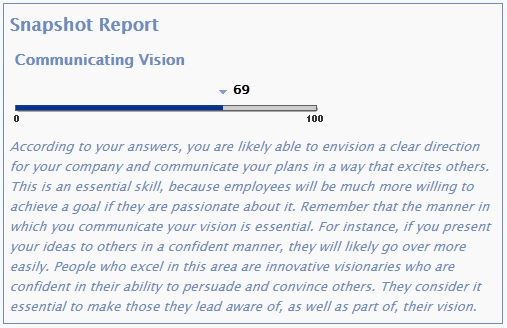
Appendix 3: Test Result 3
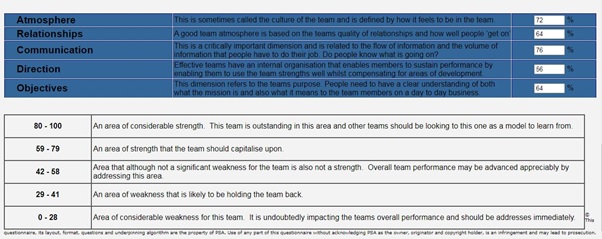
Appendix 4: Test Result 4
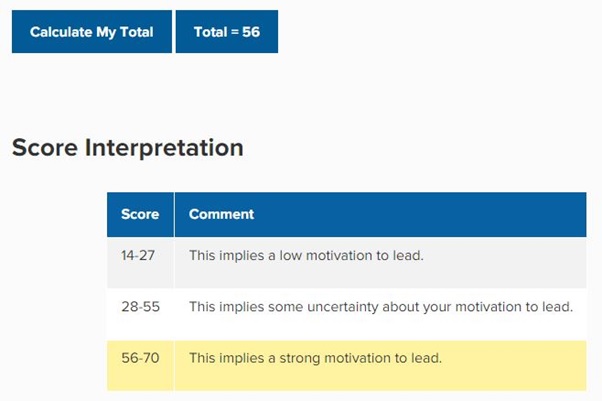
Appendix 5: Test Result 5
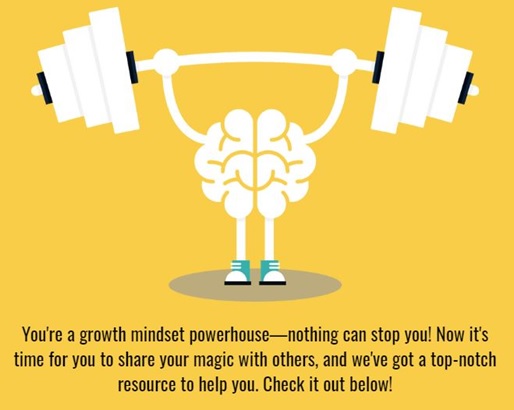
Appendix 6: Test Result 6

Appendix 7: Belbin Test Result
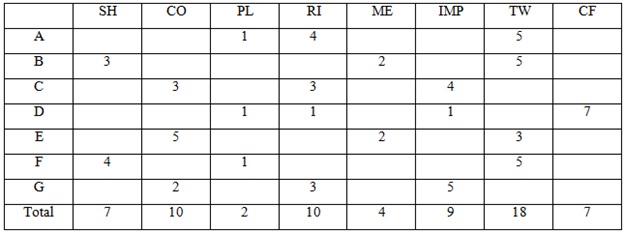
Appendix 8: Dr. Hanson Test Result
Resources
- 24 x 7 Availability.
- Trained and Certified Experts.
- Deadline Guaranteed.
- Plagiarism Free.
- Privacy Guaranteed.
- Free download.
- Online help for all project.
- Homework Help Services

